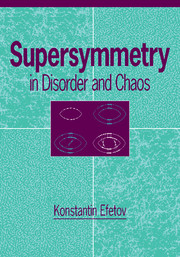Book contents
- Frontmatter
- Contents
- Preface
- Acknowledgments
- 1 Introduction
- 2 Supermathematics
- 3 Diffusion modes
- 4 Nonlinear supermatrix σ-model
- 5 Perturbation theory and renormalization group
- 6 Energy level statistics
- 7 Quantum size effects in small metal particles
- 8 Persistent currents in mesoscopic rings
- 9 Transport through mesoscopic devices
- 10 Universal parametric correlations
- 11 Localization in systems with one-dimensional geometry
- 12 Anderson metal–insulator transition
- 13 Disorder in two dimensions
- 14 Afterword
- Appendix 1 Calculation of the Jacobian
- Appendix 2 Magnetic field parametrization
- Appendix 3 Density–density correlation function at k = 0
- Appendix 4 Effective medium approximation as a saddle point
- References
- Author index
- Subject index
4 - Nonlinear supermatrix σ-model
Published online by Cambridge University Press: 10 November 2010
- Frontmatter
- Contents
- Preface
- Acknowledgments
- 1 Introduction
- 2 Supermathematics
- 3 Diffusion modes
- 4 Nonlinear supermatrix σ-model
- 5 Perturbation theory and renormalization group
- 6 Energy level statistics
- 7 Quantum size effects in small metal particles
- 8 Persistent currents in mesoscopic rings
- 9 Transport through mesoscopic devices
- 10 Universal parametric correlations
- 11 Localization in systems with one-dimensional geometry
- 12 Anderson metal–insulator transition
- 13 Disorder in two dimensions
- 14 Afterword
- Appendix 1 Calculation of the Jacobian
- Appendix 2 Magnetic field parametrization
- Appendix 3 Density–density correlation function at k = 0
- Appendix 4 Effective medium approximation as a saddle point
- References
- Author index
- Subject index
Summary
Reduction to a regular model, mean field theory
Regular model with “interaction”
The main task of this section is to represent the physical quantities discussed in the preceding chapter in such a form that one could average over the random potential at the beginning of the calculations. One way to do so is the replica trick suggested by Edwards and Anderson (1975) for a study of spin glasses. The first works on the application of field theoretical models to disorder problems were based on this trick (Wegner (1979), Schäfer and Wegner (1980), Efetov, Larkin, and Khmelnitskii (1980)). In the works of Wegner (1979) and Schäfer and Wegner (1980) kinetic quantities were written in terms of functional integrals over conventional numbers, whereas in the work of Efetov, Larkin, and Khmelnitskii (1980) integration over the anticommuting Grassmann variables was used. Then, in both approaches nonlinear σ-models that contained n × n matrices were derived. At the end of calculations one had to take the limit n → 0. The formalism of Efetov, Larkin, and Khmelnitskii (1980) was extended later to include electron–electron interactions (Finkelstein (1983, 1984)) and strong magnetic fields (Levine, Libby, and Pruisken (1984)).
The nonlinear supermatrix σ-model derived later has many common features with the replica σ-model, and it may seem that the calculations within all these models are equivalent.
- Type
- Chapter
- Information
- Supersymmetry in Disorder and Chaos , pp. 50 - 72Publisher: Cambridge University PressPrint publication year: 1996

